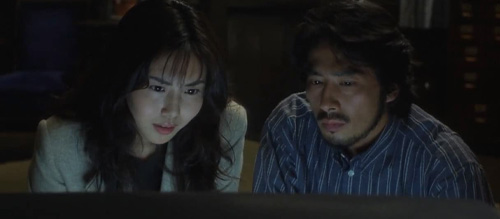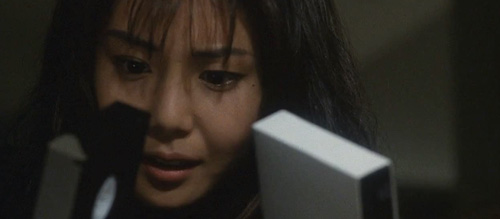Ringu (1998) Review
Ringu (1998)
Director: Hideo Nakata
Screenwriter: Hiroshi Takahashi
Starring: Nanako Matsushima, Hiroyuki Sanada, Rikiya Otaka, Miki Nakatani, Rie Ino’o, Yûko Takeuchi, Hitomi Satô
The idea of watching a horror film alone sends shivers down our spines. So we call our friends, order a pizza, and laugh as everyone peeks through closed fingers and flinches at the jump scares. We feel comfortable enjoying frightening experiences, say Haiyang Yang and Kuangjie Zhang at the Harvard Business Review, when our environment feels safe and when we remind ourselves that the horror isn’t real. Essentially, scary movies are fun because they can’t actually hurt us.
That is, until you watch Hideo Nakata’s 1998 J-horror masterpiece, Ringu.
The terror begins as an urban legend circulates amongst Tokyo’s teenagers that a cursed videotape kills its viewers seven days after they see it. So when high school student Tomoko (Yūko Takeuchi) and three of her friends mysteriously die one week after visiting a cabin in the woods, her aunt Reiko (Nanako Matsushima), a journalist, sets out to investigate.
Her search leads her back to the cabin where she watches an unmarked videotape featuring bizarre, unrelated images and ending with a fuzzy shot of a well. After she sees an apparition of a girl dressed in white with long black hair and receives a sinister phone call, Reiko is convinced that she is now cursed to die in seven days. When her ex-husband Ryūji (Hiroyuki Sanada) and their son Yōichi (Rikiya Ōtaka) also see a copy of the tape, the race against the clock becomes even more urgent.
For modern horror fans or viewers familiar with the 2002 American remake, The Ring, the film may seem slow-paced and lacking in common genre tropes. Director Nakata focuses primarily on Reiko’s investigation into the teenagers’ murders and the traumatic past of the suspected horror villain, Sadako, with very little emphasis on shock or gore. However, you won’t be disappointed by the film’s slow-burn suspense and pervading eeriness, as well as by its legendary finale.
Released at the turn of the 21st century, Nakata’s film, based on a 1991 novel by Koji Suzuki, speaks to the period’s tension between tradition and modernity brought on by rapid technological advancements. Throughout the movie, technology becomes a conduit of evil as sentient televisions and sinister phone calls spread doom and destruction. In one scene reminiscent of the 1982 horror classic Poltergeist, Reiko finds her son sitting alone in a dark room watching the videotape as the distorted image of the well envelops the boy in blue light. Here, technology acts as a virus, infecting anyone who interacts with it.
As Reiko and Ryūji uncover the origins of the apparently cursed video tape, the story moves further from the modern world and deeper into tradition and myth, including an almost literal descent into hell. Sadako, the paranormal villain herself, is based in Japanese folklore and ghost stories. According to Elena Nicolaou at Refinery29, yūrei are female ghosts in white kimonos with long black hair who died suddenly without enough time for their soul to rest. Professor Tim Screech of the University of London tells Nicolaou that the soul “will never allow itself to be laid to rest until its purpose for remaining among the living (usually revenge) has been fulfilled.” Sadako is rumoured to have had a tragic death which has set in motion her string of revenge killings in modern Japan.

In a further connection to Japanese legend, Nakata reveals to Donato Totaro at Offscreen that the story of Sadako’s mother, Shizuko, is based on a true story. The director explains that a woman named Mifune Chizuko once claimed to be psychic and, while being studied by a professor at Tokyo University, was eventually discredited and took her own life. With this knowledge, viewers may feel that the tape’s origin story is even more realistic and terrifying.
And that is where the true horror of Ringu lies.
The film may lack the genre’s characteristic jump scares, gory monsters, and epic fight scenes. But its timeless terror stems from its basis in reality and, therefore, our inability to distance ourselves from it. It plays on age-old fears of the paranormal while tapping into modern phobias of self-aware technology that we don’t fully understand. This tension makes the film a horror classic that stands the test of time.
As we continue to investigate the tension between humanity and technology in everyday life and media, such as in the hit television programme ‘Black Mirror’, Nakata’s film is just as relevant today as it was upon its initial release. And regardless of the movie’s deeper meanings and themes, there is still something obviously creepy about a killer ghost climbing out of your television screen.
As you sit down for your next scary movie marathon, consider braving Ringu. With enough friends and a pizza (or two), it’s sure to be a crowd pleaser for horror connoisseurs and their more squeamish mates alike. But be warned if you dare – your days may be numbered, unless you share the film with others and continue to spread the curse.
Score: 20/24
Recommended for you: 10 Great Japanese Horror Movies
Written by Emily Nighman


